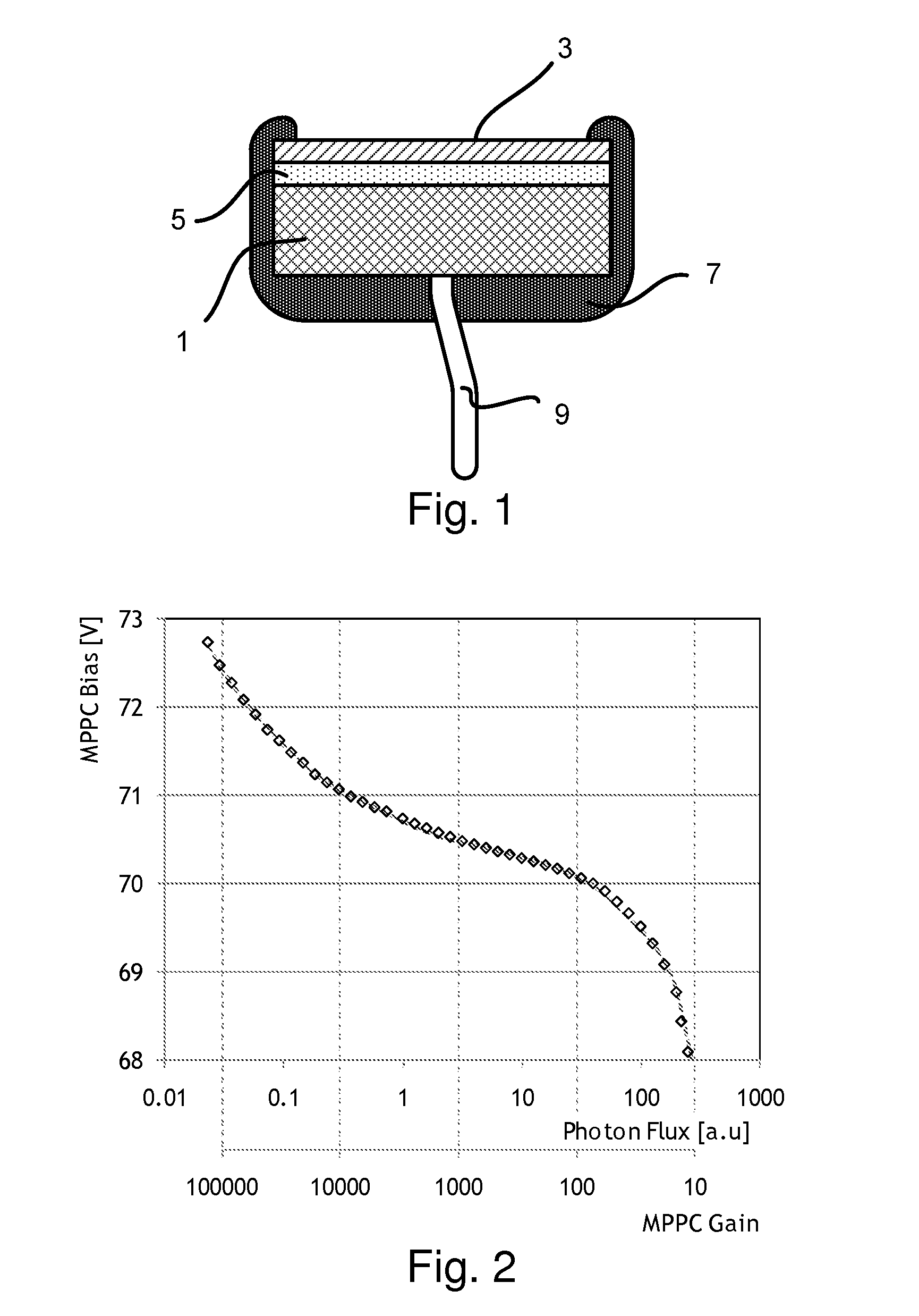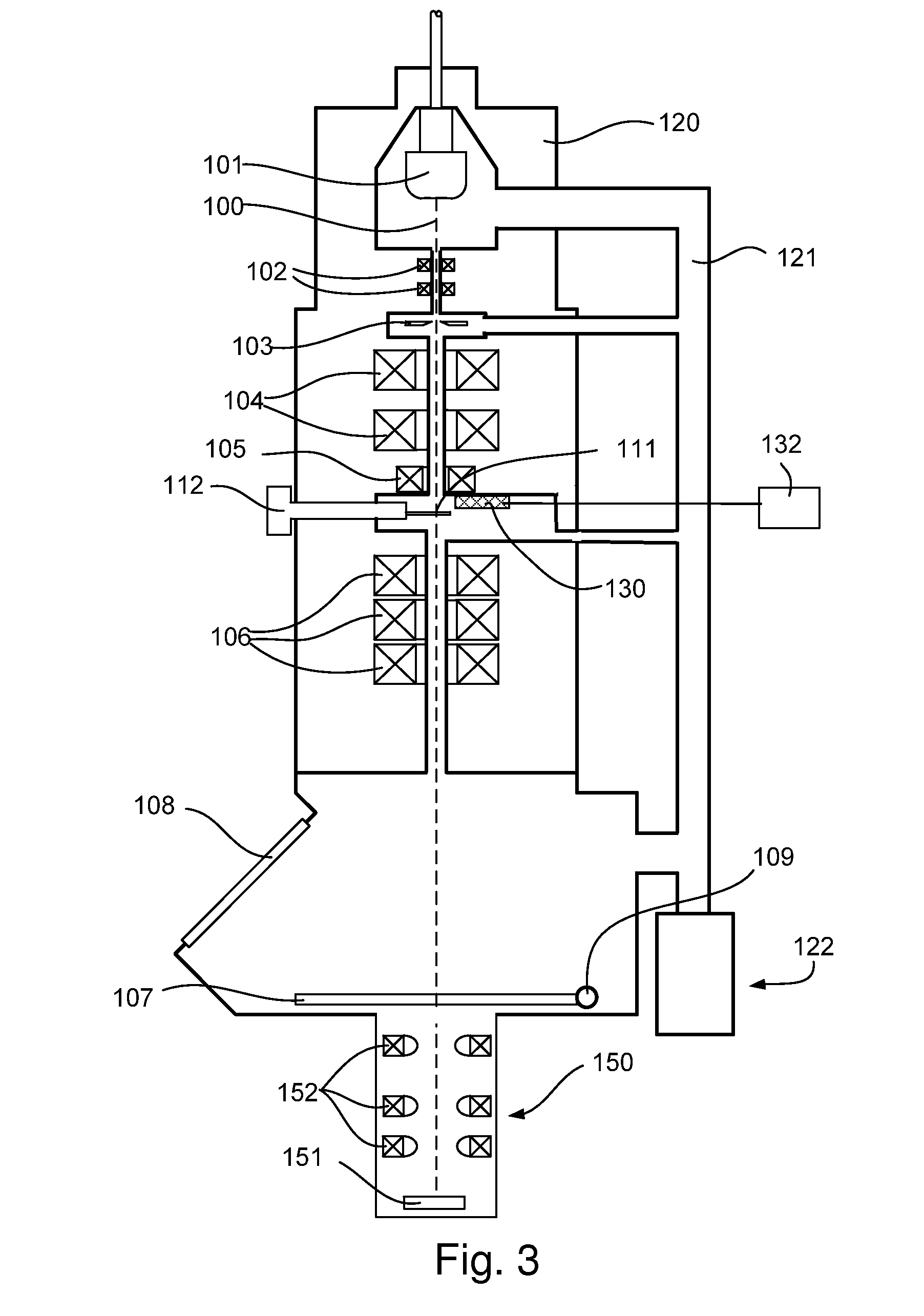Detector for use in charged-particle microscopy
a technology of charged particles and detectors, applied in instruments, heat measurement, nuclear engineering, etc., can solve the problems of affecting the degree of signal loss, and the necessity of large volume of the pmt tub
- Summary
- Abstract
- Description
- Claims
- Application Information
AI Technical Summary
Benefits of technology
Problems solved by technology
Method used
Image
Examples
embodiment 1
[0033]Multi-Pixel Photon Counters are commercially available from firms such as Hamamatsu Photonics KK, Japan (for example). A Multi-Pixel Photon Counter typically comprises a 2-dimensional array of several hundred or several thousand individual Geiger-APDs, integrated on a small chip. Such a chip typically has lateral dimensions of the order of about 3×3 mm2. In some cases, such chips can be housed in a (metal, ceramic or plastic) canister provided with electrical connection leads; however, such a canister is not necessary, and “naked” Multi-Pixel Photon Counter chips are also commercially available.
[0034]To appreciate the scale of such Multi-Pixel Photon Counter chips, the following comparison is merited. As a reference, an evacuated PMT (photomultiplier tube) with a (typical) diameter of the order of about 2½ cm and a (typical) length of the order of about 10 cm will have a volume of the order of about 80 cm3. In contrast, a canister as referred to above will typically have a vol...
embodiment 2
[0046]FIG. 1 shows a cross-sectional view of a particular embodiment of a composite Multi-Pixel Photon Counter-based detector that, in accordance with the present invention, can be used in a charged-particle microscope. The figure shows a (naked) Multi-Pixel Photon Counter chip 1 that is separated from a scintillator 3 via an interposed layer 5 of optically transparent material, such as glass or a suitable type of grease, for instance. The scintillator 3 may comprise a YAG (Yttrium Aluminium Garnet) crystal, for example.
[0047]The interposed (light guide) layer 5 serves to (partially) match the refractive indices of the scintillator 3 and Multi-Pixel Photon Counter 1, and also to electrically isolate them from one another. In use, the Multi-Pixel Photon Counter 1 will be operated at a relatively low voltage, whereas the scintillator 3 will often be maintained at a relatively high electrical potential (typically of the order of kV). To prevent arc-over, the sandwiched assembly 3, 5, 1...
embodiment 3
[0049]FIG. 2 shows a graph of gain versus bias for a particular embodiment of an Multi-Pixel Photon Counter, obtained using the insights underlying the current invention and exploitable according to the invention in a detector for application in a charged-particle microscope. In this specific case, the Multi-Pixel Photon Counter is a type / model S10931-25P, obtainable from Hamamatsu Photonics KK, Japan, and containing a 2-dimensional array of 14400 Geiger-APDs in a 3×3 mm2 die (chip) area. For this particular Multi-Pixel Photon Counter, the manufacturer specified an operating voltage of approximately 74V; however, for other Multi-Pixel Photon Counters, manufacturers can specify different operating voltages (depending inter alia on the details of the integrated circuit design in the MPPC in question).
[0050]In a test associated with the present invention, the Multi-Pixel Photon Counter in question was subjected to an out-of-spec operating voltage. The graph in FIG. 2 shows the surprisi...
PUM
 Login to View More
Login to View More Abstract
Description
Claims
Application Information
 Login to View More
Login to View More - R&D
- Intellectual Property
- Life Sciences
- Materials
- Tech Scout
- Unparalleled Data Quality
- Higher Quality Content
- 60% Fewer Hallucinations
Browse by: Latest US Patents, China's latest patents, Technical Efficacy Thesaurus, Application Domain, Technology Topic, Popular Technical Reports.
© 2025 PatSnap. All rights reserved.Legal|Privacy policy|Modern Slavery Act Transparency Statement|Sitemap|About US| Contact US: help@patsnap.com



